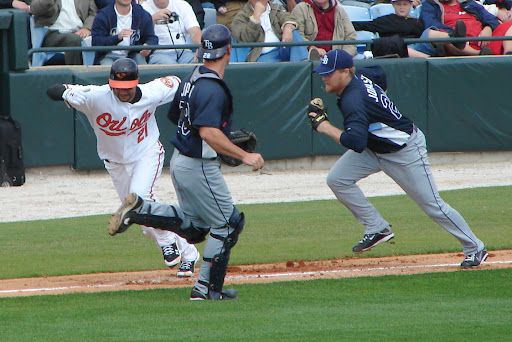Rundowns – two priorities
January 27, 2011 by Coach McCreary
Filed under Coaching, Infield, Practice
If you are ever looking for a good indoor drill with your team, it’s rundowns. With or without runners, rundowns are as simple as creating some lines of guys about 90 feet from each other. First guy up has the ball and runs to the other line, tosses the ball to the first guy in the opposing line and then goes to the end of that group’s line. The relay style drill just goes back and forth until the coach has seen enough and can involve multiple lines of rundowns.
There are a number of little things that players should do to perform a rundown correctly but, except for two of them, I’ll save them for a future post. Here are the two priorities that must be done in order for a rundown to work with the least amount of throws. A team can come up short in a few of the other little things but not these.
 |
| Move forward to catch and sprint at the runner! (Photo by Jim Donten) |
Get the runner to go full speed. It may take a throw or two to get him moving that fast but after you do, only one additional throw should be needed. A runner at full speed cannot stop, turn, and run in the other direction very easily. The slower the runner goes the more likely he is going to be able to change directions on each throw thus lengthening the play. More throws = more chance of errors for the team on defense. Any fielder that gets the ball must sprint at the runner to make him sprint also. Anything less and the advantage goes back to the runner.
Move forward to catch: The player who is receiving the toss from his teammate needs to be moving forward as he catches the ball, assuming the throw is accurate. As soon as the fielder sees the teammate about to release the ball, he takes a step forward to catch. When the runner is going full speed and the fielder moves forward as he catches the ball, the runner will usually just run into the tag since he cannot stop and turn around fast enough. Catching the ball standing still allows the runner more time to change directions because it takes time for the fielder to catch and then get started running. Moving forward to catch eliminates this lag time.
When practicing this drill, do it without runners first so players can focus on the two priorities – running as fast as they can and moving forward to catch. Introduce runners to the drill after the priorities are met.





Leave a Reply